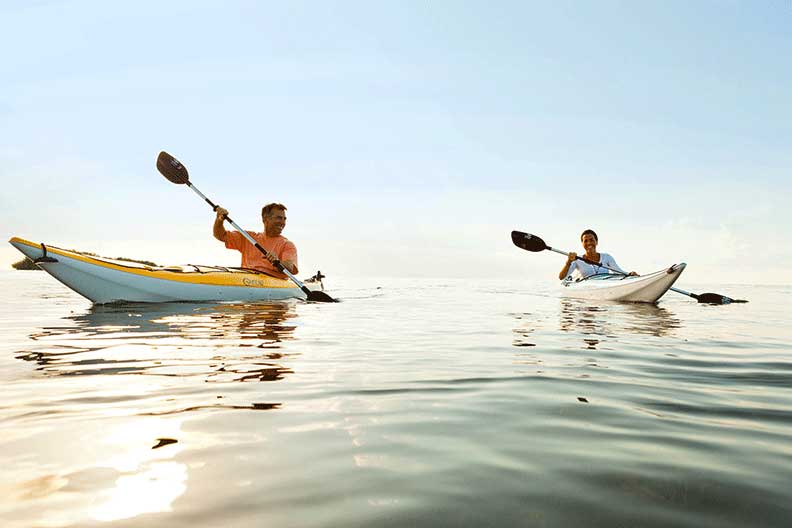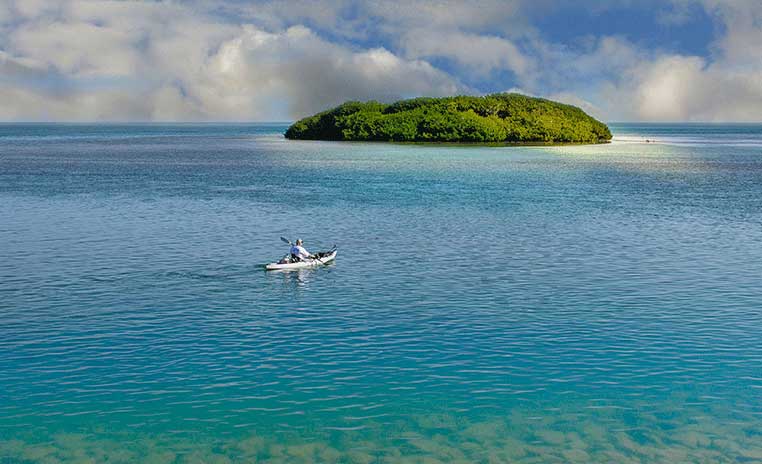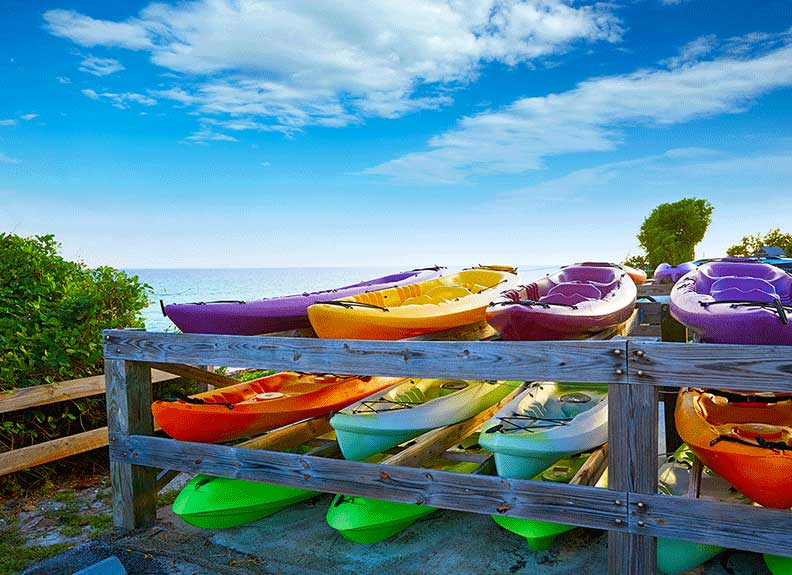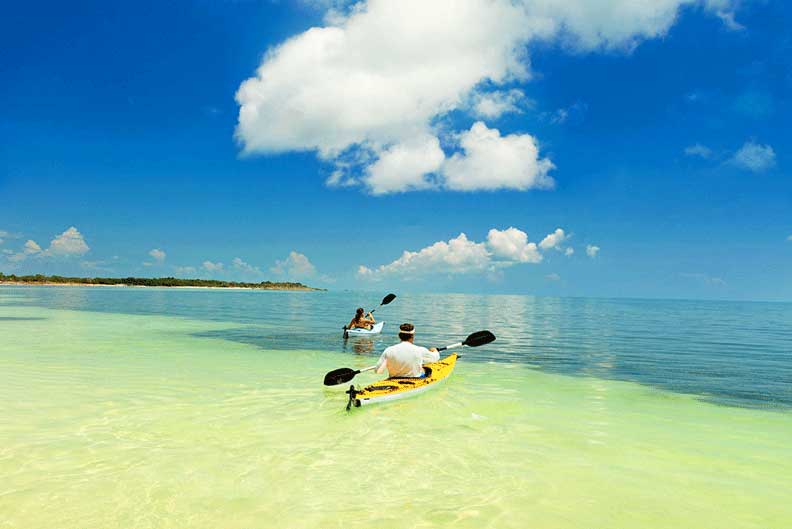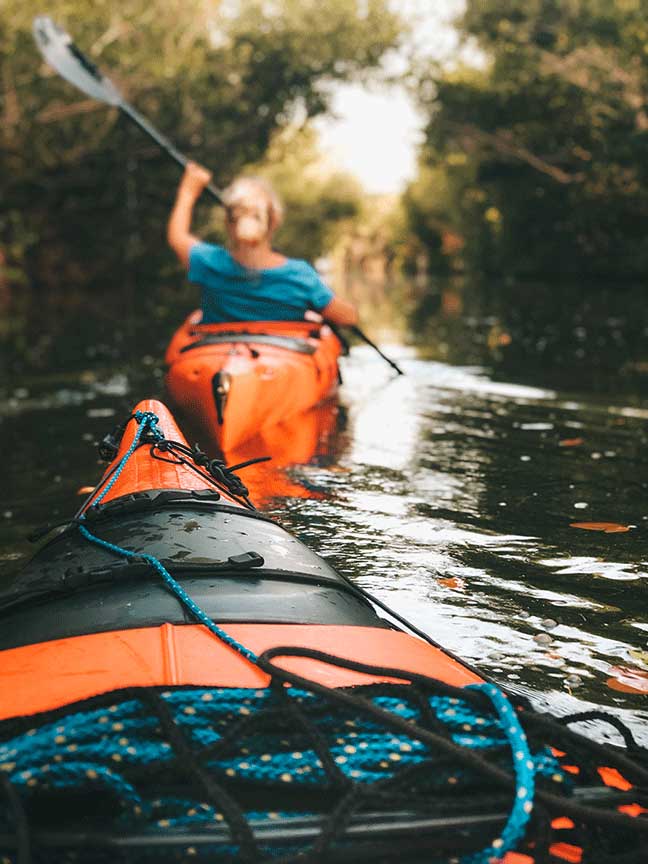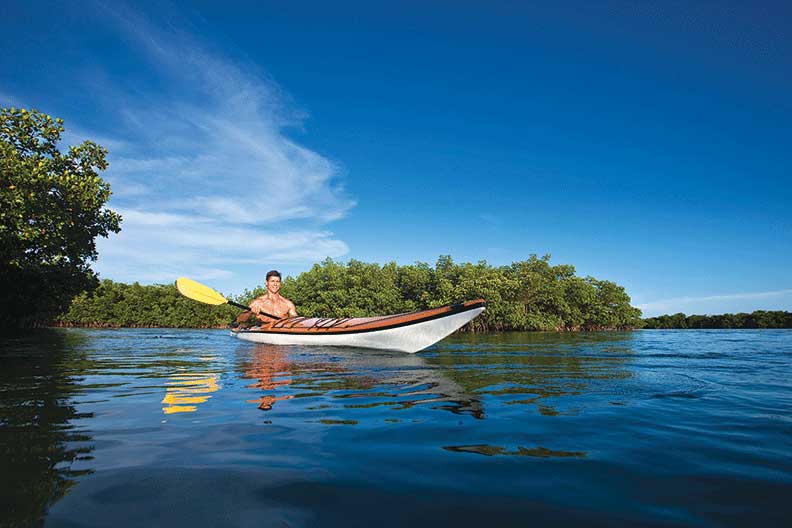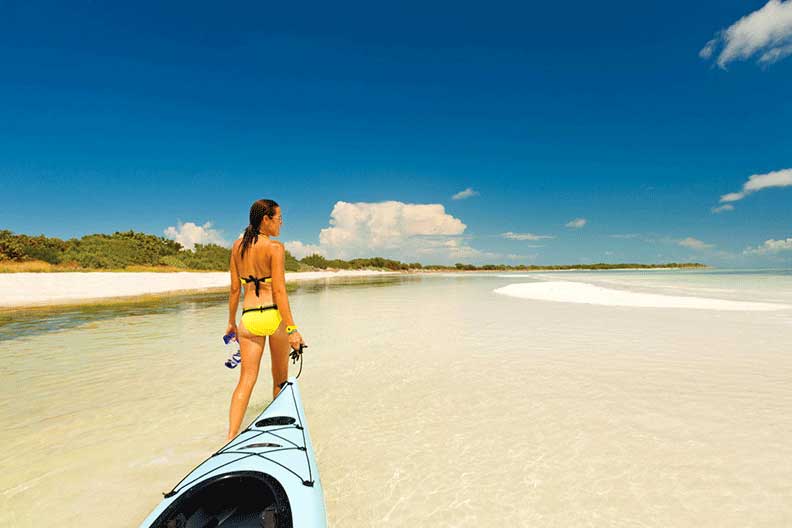Get a close look at the natural side of Florida’s Lower Keys from the seat of a kayak
Kayaks are ideal for exploring the vibrant ecosystems that flourish in Florida’s Lower Keys from Bahia Honda to Big Pine Key and other untamed keys on the island chain between the Gulf of Mexico and the Atlantic.
With a low profile that puts paddlers close to the surface of the water, kayaks give explorers a chance to get within touching distance of the surrounding flora and fauna. And kayaks’ nimble size makes them ideal for exploring narrow channels, mangrove tunnels and shallow coves that contain some of the Lower Keys’ most beautiful attractions.
Kayaks also can be put to use for trips deeper into the ocean, although these kinds of outings are recommended for more experienced paddlers. Regardless of your choice, you’ll discover that the Lower Keys are ideal kayaking territory, with calm waters and moderate temperatures inviting adventurers to hit the water in the slim-hulled craft for once-in-a-lifetime adventures.
Choose Your Watercraft
Travelers who haven’t hit the water in a kayak before face a lot of choices. If you plan to bring your own watercraft, an RV is a great way to go. Shoppers will find roof- and hitch-mounted racks to secure these small vessels to your vehicle. Pick your destination, set out from Florida on the Overseas Highway, then set up camp in a tropical paradise.
If you’re in the market for a kayak, consider all your options. If portability is a concern, inflatable kayaks can fit in a confined space, making them perfect for RV travel. Aspiring kayakers should also consider how they plan to use their craft. Recreational kayaks, for example, are wide and stable with big cockpits, making them ideal for long, lazy days of traveling in relatively calm water. Sea kayaks, on the other hand, are built thin for speed and straight tracking; these also have small cockpits, some equipped with skirts to prevent the entrance of water. For the Florida Keys, chances are, you’ll be going with a recreational kayak.
If you’re a novice kayaker, you’ll find plenty of outfitters on Big Pine Key, Bahia Honda and other destinations who will get you started. Some companies offer group tours led by experienced guides; this is a great way to get acquainted with the fun and challenges of kayaking. On some tours, outfitters will transport kayaks via boat to backcountry areas for secluded kayaking experiences.
Safe and Secure
Regardless of your kayaking adventure, it’s critical to take basic safety measures. Always wear a personal flotation device, and bring sunblock and water to fight the sun and heat. Keep in mind that there’s always a high possibility of getting wet. Use dry bags to keep food, camera and other fragile items protected. You’ll be thankful you made this investment if a wave or wake from a boat splashes into your cockpit, dousing you and all your belongings!
If you’re bringing your own kayak, make sure to reserve a spot at an RV park that’s fairly close to a boat-launch area. Porting your little vessel from the campsite to shore shouldn’t take up a good part of your day. In some areas, kayakers are able to secure their vessels near the launching point, sparing you the hassle of hauling the kayak back to your campsite. Bring a lock and cable for this situation.
The Lower Keys offer several islands that serve as launching pads for kayaking adventures. Here’s a roundup of some of the top destinations:
Bahia Honda
Sitting on Mile Marker 37 on the Overseas Highway, this 500-plus-acre key is surrounded by clear blue water, making it a sought-after kayaking destination. Three campgrounds offer a total of 80 sites for RVers and tenters. Outfitters on the island can get you started on kayaking adventures. The spectacular scenery here includes the historic Bahia Honda bridge, a 5,055-foot railroad span built a century ago that connects Bahia Honda with Spanish Harbor Key to the west. Although the span is now derelict, the elegant steel-truss structure serves as a stunning backdrop for photos.
On the bay side of the island, the clear waters sometimes reveal views of sharks and tarpons. Adventurous kayakers can set out on open water to reach Little Bahia Honda Island, two-thirds of a mile off the southwest tip of Bahia Honda. Set out from the kayak launch at Loggerhead Beach and prepare for a vigorous paddle.
Although Little Bahia Honda is only 300 feet across and home to two trees, it has several tidepools on its rocky surface. Snorkeling around this tiny island is outstanding for folks who want to mix things up. If you haven’t kayaked in open water before, it’s a good idea to know how to reenter your kayak after capsizing.
Big Pine Key
About 4 miles west from Bahia Honda across the Overseas Highway is Big Pine Key, one of the largest islands in the Lower Key chain. More than half the island’s 9.9-square-mile surface is set aside for National Key Deer Refuge, but kayakers will find lots of paddling trails on the island’s interior as well as on its coast. Guides on the island will take paddlers on backcountry tours, introducing them to truly wild environments.
Got a Florida fishing license? Then you can drop a line into the clear waters from the convenient base of a kayak. Big Pine Kayak Adventures shows kayakers how to navigate into extremely shallow waters to stalk bonefish, sharks, barracuda and many other species. Trips include all fishing tackle.
Directly off Big Pine Key’s south coast, 6,000 acres of ocean have been set aside for Coupon Bight Aquatic Preserve, protecting the area’s delicate mangrove and lagoon ecosystem. Kayakers can paddle around the islands and lagoons to view rare wading birds. This area also harbors Florida lobster and a wide variety of fish, so bring a rod. On the ocean side (west) of the preserve, kayakers will discover the small Newfound Harbor Keys along with patch coral reefs. Head north from here to see the Coupon Bight lagoon, a mangrove-rich tropical body of water fringed with seagrasses. You may spot sea turtles resting on the beach here.
No Name Key
Kayakers can get a unique look at mangroves by navigating the “mangrove tunnels” — waterways that snake under the dense canopies of these trees. One of the best places to explore these tropical passageways is No Name Key, located directly to the east of Big Pine Key across the Bogie Channel on State Road 4A. Start at the Keys’ Old Wooden Bridge resort to launch your tour through the tunnels. As you navigate these shady passages, you might catch a glimpse of a heron or the diminutive Key deer. Keep your eyes peeled for sunken boats found along the way.
Summerland Key
From Big Pine Key, travel about 6 miles west across the Overseas Highway to reach Summerland Key. Here, kayaks can launch in shallow water and explore surrounding lagoons, bays and islands. Look for the “holes” in the bays that are said to harbor large populations of fish, ideal for kayak angling.
Saddlebunch Keys
Seventeen miles west of Big Pine Key, this under-the-radar cluster of islands gives outdoor lovers a chance to explore nature right off the Overseas Highway. Launch at Mile 16 and enjoy the waterways that some have called “the center of the kayaking universe.” Mangroves, beautiful coasts and lots of marine life make this a special place that feels a world away from civilization
Geiger Key
Take a backcountry tour on this small island and discover a world of peaceful blue shallow waters, mangrove trails, swimming holes and morning sun. Outfitters offer tours into the many trails that lead to the island’s interior.
Great White Heron National Wildlife Refuge
For a true backcountry experience, the Great White Heron National Wildlife Refuge, north of Big Pine Key, provides a safe home for its namesake seabird and other animals. The protected area’s 200,000 acres of open water and islands serve as valuable nesting, feeding and resting space for the once-endangered species. Visitors can take a Lower Keys ecotour to the refuge and cruise around the clear waters to spot herons as well as turtles, sharks, stingrays, eagle rays and herons. This is an ideal spot for wildlife observation and photography, interpretation and environmental education.
Stock Island
Can’t get enough of those mangrove passages? Stock Island’s so-called Mosquito Coast is ripe for kayak exploration. Outfitters like Lazy Dog will take paddlers on a winding journey through mangroves for an in-depth look at the local ecosystem. Single or double kayaks are available.
For More Information
Learn more about Florida’s Lower Keys.

